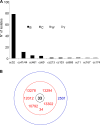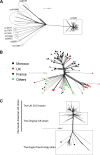Molecular Characterization of Invasive Isolates of Neisseria meningitidis in Casablanca, Morocco
- PMID: 29743304
- PMCID: PMC6018341
- DOI: 10.1128/JCM.00445-18
Molecular Characterization of Invasive Isolates of Neisseria meningitidis in Casablanca, Morocco
Abstract
Meningococcal epidemiology may change unpredictably, and typing of Neisseria meningitidis isolates is crucial for the surveillance of invasive meningococcal disease (IMD). Few data are available regarding the meningococcal epidemiology in countries of North Africa. We aimed to explore invasive meningococcal isolates from the Casablanca region in Morocco. We used whole-genome sequencing (WGS) to characterize 105 isolates from this region during the period of 2011 to 2016. Our data showed that the majority (n = 100) of the isolates belonged to serogroup B. Genotyping indicated that most of the isolates (n = 62) belonged to sequence type 33 of clonal complex 32. The isolates also showed the same PorA and FetA markers and clustered together on the basis of WGS phylogenetic analysis; they seemed to correspond to an expansion of local isolates in the Casablanca region, as reported for similar isolates in several other countries. These data suggest that serogroup B isolates may predominate in Morocco, which may have an important impact in the design of vaccination strategies.
Keywords: MLST; meningococcal disease; serogroup B disease; typing; whole-genome sequencing.
Copyright © 2018 American Society for Microbiology.
Figures



References
-
- Pollard AJ. 2004. Global epidemiology of meningococcal disease and vaccine efficacy. Pediatr Infect Dis J 23(Suppl):S274–S279. - PubMed
-
- Borrow R, Alarcon P, Carlos J, Caugant DA, Christensen H, Debbag R, De Wals P, Echaniz-Aviles G, Findlow J, Head C, Holt D, Kamiya H, Saha SK, Sidorenko S, Taha MK, Trotter C, Vazquez Moreno JA, von Gottberg A, Safadi MA. 2017. The Global Meningococcal Initiative: global epidemiology, the impact of vaccines on meningococcal disease and the importance of herd protection. Expert Rev Vaccines 16:313–328. doi:10.1080/14760584.2017.1258308. - DOI - PubMed
-
- Harrison LH, Pelton SI, Wilder-Smith A, Holst J, Safadi MA, Vazquez JA, Taha MK, LaForce FM, von Gottberg A, Borrow R, Plotkin SA. 2011. The Global Meningococcal Initiative: recommendations for reducing the global burden of meningococcal disease. Vaccine 29:3363–3371. doi:10.1016/j.vaccine.2011.02.058. - DOI - PubMed
Publication types
MeSH terms
Substances
Grants and funding
LinkOut - more resources
Full Text Sources
Other Literature Sources
Medical

